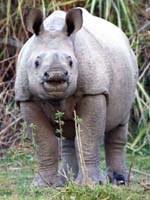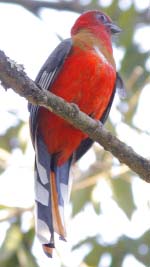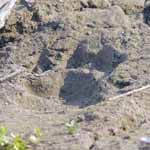
Starting
early from Guwahati, The journey to Kaziranga on NH37 via Nagaon is easily
made in six hours and the trouble taken is well worth the effort to this UNESCO
world heritage site.
Kaziranga is centrally located in the state of Assam nestled in a parallel
stretch to the mightiest river Brahamaputra, which forms its northern boundary,
in an East west direction.
It mainly consists of vast Elephant grasslands interspersed with forests and
large and mainly shallow water-bodies called Beels.
NH37 and the Karbi Anglong hills demarcate the Parks' southern boundary.

Kaziranga can roughly be divided into three zones, the west zone 'Baghori'
which you hit first; mid zone 'Kohora' with all the varied options for lodges;
and the eastern zone 'Agaratoli' for a large area and many birds. Panbari
forests and many tea gardens are the other good places for birding.

However the lowlands of Kaziranga are known for providing a secure habitat
for much of wildlife. One-horned Rhino, Swamp/Hog Deer etc., Water Buffalo,
Wild Elephant, Wild Boar, Otter, Capped Langur and Tiger pugmarks are easily
seen. Walking the Panbari forests also reveals the endangered Hoolock Gibbon.
The forests are also known to harbour Sloth Bear, Leopard Cat, Jungle Cat,
Hog Badger, Indian Bison, Python, Monitor Lizard etc.
Overall the park is very nicely managed by the Kaziranga forest staff and
sees a large nos. of tourists each year.
The park has an entry fee per person, camera fee and vehicle fee. A forest
guard also accompanies who can double up as a guide with some charges. Vehicles,
mainly jeeps are arranged more reasonably at Kohora chowk. An option for elephant
safari exists but advance booking is mostly required. The park has restricted
entry timings so all the rides must be planned carefully in advance.
The best period to visit the park is from mid November to mid April.
***
We made our trip from 7-10 Jan, 2008 when the weather had warm days and cool
evenings in store for all of us.
The visit was made with an open mind and an ordinary place was chosen for
staying with no assistance from popular birding guides, though the regional
checklist was scanned beforehand. It turned out that the jeep driver had knowledge
of many birds hence he gave us good company and was encouraged to learn even
more. Of late, many birders popularizing the place are surely helping indirectly
the rare bird and are encouraging these local guides towards conservation
efforts.
Attempt was made to record all the birds encountered. We started almost immediately
after dumping our baggage in the rooms and just as we were settling in the
jeep to head towards Kohora a movement through the Bamboo thickets nearby
caught the eye. The fragile looking bird turned out to be a Red-headed Trogon
and of course we were delayed by the next ten minutes or so till the time
the bird gave us company. It was a very nice beginning indeed.
start loading thumbnails (long
list)clear
1.
2.
3.
4.
; flitting
about the high branches.
5.
6.
; emerged
from a bamboo clump in mid afternoon with staccato flights from one tree to
the other
7.
8.
9.
10.
11.
12.
13.
14.
15.
16.
;
a large party was seen but they remained elusive and only one surfaced for a
few moments
17.
18.
19.
20.
21.
22.
23.
24.
25.
26.
27.
28.
29.
30.
31.
32.
33.
34.
35.
36.
37.
38.
39.
40.
41.
42.
43.
44.
45.
46.
47.
48.
49.
50.
51.
52.
53.
54.
55.
56.
57.
58.
59.
60.
61.
62.
63.
64.
65.
 Starting
early from Guwahati, The journey to Kaziranga on NH37 via Nagaon is easily
made in six hours and the trouble taken is well worth the effort to this UNESCO
world heritage site.
Starting
early from Guwahati, The journey to Kaziranga on NH37 via Nagaon is easily
made in six hours and the trouble taken is well worth the effort to this UNESCO
world heritage site. 
 However the lowlands of Kaziranga are known for providing a secure habitat
for much of wildlife. One-horned Rhino, Swamp/Hog Deer etc., Water Buffalo,
Wild Elephant, Wild Boar, Otter, Capped Langur and Tiger pugmarks are easily
seen. Walking the Panbari forests also reveals the endangered Hoolock Gibbon.
The forests are also known to harbour Sloth Bear, Leopard Cat, Jungle Cat,
Hog Badger, Indian Bison, Python, Monitor Lizard etc.
However the lowlands of Kaziranga are known for providing a secure habitat
for much of wildlife. One-horned Rhino, Swamp/Hog Deer etc., Water Buffalo,
Wild Elephant, Wild Boar, Otter, Capped Langur and Tiger pugmarks are easily
seen. Walking the Panbari forests also reveals the endangered Hoolock Gibbon.
The forests are also known to harbour Sloth Bear, Leopard Cat, Jungle Cat,
Hog Badger, Indian Bison, Python, Monitor Lizard etc.